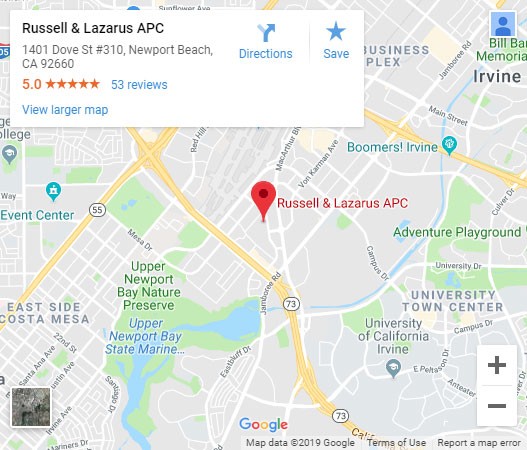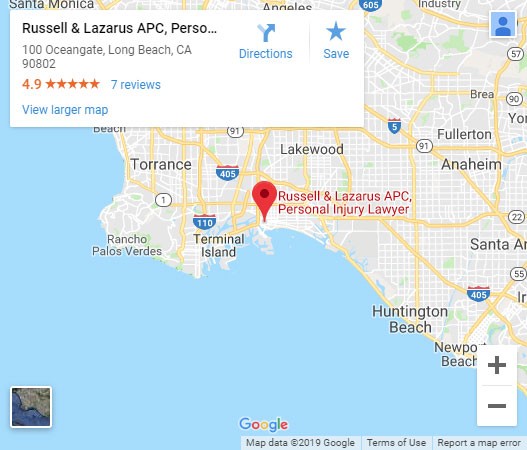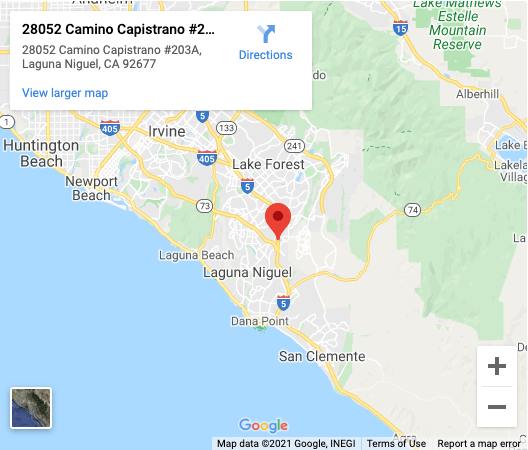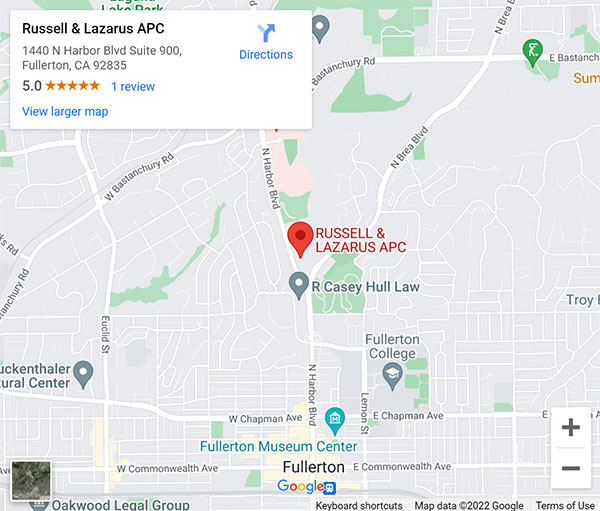Orange County Car Accident Guide

Dealing with the Aftermath of an Orange County Car Accident
If you have been involved in a car accident, you are probably familiar with the feelings that flood your body from the moment the impact occurs, and you hear the awful sound of metal on metal. You may feel as though the accident happened in the blink of an eye—and that time almost stood still during the accident. In fact, there is not a single word that can fully describe the experience of being involved in a car accident. Even if you know what should be done following a car accident, you can feel frozen—unable to take the steps you know should be taken. And if you seriously injured, all of these feelings are likely magnified.
Your thoughts may be running wild, as you attempt to think clearly. What will you do if you cannot return to work? Who will take care of your responsibilities? How will you pay your bills? What about your medical bills? How will you get your car repaired while you are recovering? You don’t think the accident was your fault, but what if it was? Will your insurance rates increase? Will your insurance company drop your coverage altogether? The questions literally flood your brain. Feelings of panic begin to creep in as you ask a bystander to contact the police. While realistically, you know you will get through this, fixing the mess you are looking at can feel entirely overwhelming.
You can be the safest driver in the state of California and still end up dealing with a car accident; just because you drive safely does not mean every other driver does. The negligence of another driver can result in life-altering consequences for you and your loved ones. It can take a significant amount of time to get back to where you were prior to the accident—as well as a significant amount of patience. The single most important thing you can do for your recovery and your future following your Orange County car accident is to contact an experienced car accident attorney. Having a top injury lawyer in Orange County by your side from start to finish can truly make a difference in the outcome of your car accident.
The attorneys at Russell & Lazarus APC have over 30 years of experience helping people just like you. We deal with the details of your car accident, allowing you the time to heal, both physically and mentally. We will deal with the insurance company, help you get the medical treatment you need, file a claim on your behalf, negotiate a fair settlement, and, when necessary, litigate your case. We are by your side, and we are on your side. At Russell & Lazarus APC, we will never allow an insurance company to take advantage of you. We understand your anxiety and frustration and will work hard to ensure you feel more hopeful after meeting with a Russell & Lazarus experienced car accident attorney. For exceptional service throughout your entire cases, the Russell & Lazarus attorneys are here for you.
How Does California Law Apply to Orange County Car Accidents?
You may wonder how you will prove the other driver caused the accident—or perhaps, you believe you were at least somewhat responsible for the accident and are anxious about that. Liability in a car accident is based on the legal theory of negligence, which describes a situation in which a person acts in a careless manner, resulting in another person being hurt and/or property being damaged. Acting in a careless manner means the person failed to act in the same manner as another reasonable person would have done, given the same set of circumstances. To fully prove negligence, it must be first shown that the other driver was careless and that his or her carelessness was the direct cause of the accident. Next, it must be shown that the car accident resulted in your injuries and/or property damage. To put it in a more legal manner, it must be shown that:
- The other driver owed you a certain duty of care;
- The other driver breached his or her duty of care;
- That breach of duty caused your Orange County car accident;
- The car accident caused by the driver’s breach of duty caused your injuries, and
- The negligent driver has the duty to make you whole again—that is, to pay for your medical expenses and any other expenses you incur related to the accident.
Other legal issues related to your Orange County car accident include the following:
Contributory or Comparative Negligence?
Each state chooses the system it operates under as far as auto accident negligence. States which fall under contributory negligence dictate that if you were even partially at fault for the accident, there will be no recovery. This means that if you were only one percent at fault for the car accident and the other driver was 99 percent at fault, you are not entitled to any compensation.
There is one exception to the rule of contributory negligence, and it is known as the Last Clear Chance Rule. Under this rule, you could still recover compensation if you can show the other driver had a last clear chance to avoid an injury. Contributory negligence is followed by a minority of states in the United States. California follows the rule of comparative negligence, as do the majority of states in the U.S. There are two types of comparative negligence: pure comparative negligence and modified comparative negligence.
Under pure comparative negligence, plaintiffs are compensated for damages based on the percentage of fault of each party. If the plaintiff’s percentage of negligence does not exceed a set level, then he or she may recover compensation from the driver who is more at fault for the accident. A judge or jury determines the percentage of fault for both the plaintiff and the defendant. The state of California uses a pure comparative negligence system to determine compensation for the plaintiff—a system that can also function as a defense for the defendant who is involved in a multi-car accident.
If the defendant can show that his or her actions only accounted for, say, 20 percent of the fault for the entire accident, it is unlikely any plaintiff would receive an award of damages when there are multiple parties involved. Under pure comparative law, if you were hit by a driver who is found to be 90 percent at fault for the accident, and the jury awarded you $200,000 for economic, non-economic, and punitive damages, you would receive $180,000. There are currently 13 states which use the pure comparative negligence system of recovery, including California.
Minimum Requirements for California Auto Insurance
Just as each state chooses the type of insurance laws it operates under, each state also chooses the minimum insurance requirements. In the state of California, the minimum requirements include $15,000 for bodily injury and death per person, $30,000 total bodily damage coverage, and $5,000 in property damage. Keep in mind, these are the minimums required under California law, and whenever possible, you should always have more coverage than the required amount.
Uninsured/Underinsured Motorist Coverage
More than 15 percent of California drivers have no auto insurance, despite the legal requirement to do so. While you might assume these drivers are simply flouting the law, in fact, a significant majority of uninsured motorists simply do not have the financial resources to allow them to purchase auto insurance. Unfortunately, insurance companies also discriminate against lower-income drivers by charging them more—even those who have a clean driving record. While uninsured/underinsured motorist coverage is optional in California, the party waiving such coverage must do so in writing.
The minimum uninsured/underinsured motorist coverage is $30,000 per person and $60,000 total for bodily damage. Thirty-three states in the U.S. fine first-time offenders with no auto insurance a fine of $500 or more, thirty-two states suspend the license of the uninsured motorist, and fourteen states hand down jail time for those without auto insurance. The state of California is a bit more lenient than many other states; a first-time offense of having no auto insurance can result in a fine from $100-$200, while a second offense can result in a fine from $200-$500.
California Car Accident Statistics
According to the California Office of Traffic Safety, traffic fatalities in the state increased by seven percent between 2015 and 2016. Alcohol-impaired driving fatalities also increased from 911 in 2015 to 1,059 in 2016. In addition to alcohol-impaired driving fatalities, in 2016, 15 percent of all drivers killed in motor vehicle accidents tested positive for a legal or illegal drug. Despite the vast educational campaigns regarding seatbelt usage, the number of unrestrained vehicle occupant fatalities increased by three percent between 2015 and 2016. The found the following streets/intersections to be those with the highest number of auto accidents in the entire Orange County:
- Anaheim Blvd. and State College Blvd.
- Tustin Street and Walnut Avenue
- Glassell Street and Meats Avenue
- Meats Avenue and Tustin Street
- Katella Avenue and Tustin Street
What are the Most Common Types of Injuries from an Orange County Car Accident?
Depending on the specific circumstances surrounding your Orange County car accident—including the severity of the impact—you could suffer injuries ranging from minor to severe or even life-threatening. The injuries you suffer from a car accident could prevent you from returning to work for a week, several weeks, months, a year, or forever. This is one of the most difficult aspects of car accidents. One moment you may be headed home after work, thinking about your plans for the weekend, and the next you are being loaded into an ambulance thanks to the negligence of the driver who hit you.
- The most common auto injury is whiplash—a neck injury which can occur at speeds as low as five miles per hour and can manifest immediately after the accident, days after the accident, or even weeks after the accident. Whiplash is a sudden forward and/or backward movement of the head during a car accident, which can cause joint dysfunction and postural abnormalities. Those who suffer whiplash following a car accident may have symptoms for an average of six months after the car accident, although from 20-40 percent of those who are diagnosed with whiplash will have symptoms that persist for years. When you consider that the impact on the driver is 5 times greater than the force to the vehicle itself, you can clearly see why whiplash can be so serious.
- The neck position at the time of the accident will also play a role in the level of damage to the neck. More than 55 percent of those who had persistent neck pain and related symptoms from two years or more after the car accident reported their head was “rotated” at the time of impact. There has been a fair amount of discussion as to whether whiplash is worse when you expect it and “brace” for impact as opposed to when the accident is unexpected.
- Brain injuries and head trauma—Brain and head injuries can occur in any car accident, even when there are no overt signs of bruises, cuts, or bleeding. Car accidents are the primary cause of traumatic brain injury in the United States. When the brain is slammed into the hard bones of the skull, a closed head injury can result. This closed head injury can range from a mild concussion to traumatic brain injury. Brain damage can cause memory loss, cognitive issues, chronic fatigue and headaches, insomnia, sensory and motor skill problems, vertigo, and temporary or permanent brain function impairment. Brain injuries can be difficult to diagnose and can alter the course of the victim’s life. Brain injuries can also create significant financial burdens for the victim and his or her family simply to stay ahead of the never-ending medical bills.
- Back injuries and spinal cord injuries—Car collisions can result in disc injuries, lumbar spinal injuries, fractures, strains, and sprains due to the torque on the body at the time of impact. Like neck injuries and whiplash, back injuries can manifest hours, days, or weeks after the accident. A severe back injury can lead to chronic pain as well as leaving the victim unable to return to work or to his or her normal day-to-day activities. Those who suffer a more serious spinal cord injury could end up a paraplegic or quadriplegic, confined to a wheelchair, and largely unable to care for themselves. Spinal cord damage can also cause breathing difficulties, loss of bladder and bowel functions, swelling, internal bleeding, alteration of the senses, and pain or weakness of the muscles. The financial impact of a spinal cord injury is devastating to victims and families. The lifetime cost of care required for a paraplegia victim can be from $2 million to $3.5 million, while the lifetime cost of care required for a quadriplegia victim can be in the tens of millions of dollars.
- Amputations and burns—The loss of a body part is known as an amputation, which can include the loss of fingers, hands, arms, feet, and legs. An amputation can also include the loss of a victim’s ears, nose, lips, tongue, and cheeks, which brings disfigurement to the face. Since our identity is often closely associated with our looks, these types of injuries can cause long-lasting psychological trauma. Burns to the face and body can also result in disfigurement, with the same type of trauma. Facial lacerations can occur when the face comes into sudden contact with a steering wheel, side window, shattered glass, scrapes, bruises, and burns.
- Internal organ damage—An automobile accident can lead to severe internal injuries. These injuries can include damage to the lungs, stomach, kidneys, liver, spleen, reproductive organs, and heart. Often, a person who has been involved in a car accident is unaware of damage to the internal organs until later. At the time of an accident, the body is flooded with adrenaline. This adrenaline can mask injuries, which is why many people are unaware they are injured until hours or days later.
- Broken bones and fractures—Knee and ligament damage are the most common types of broken bones and fractures, occurring when the knees come into contact with the dashboard. Those with broken bones and fractures may require surgery to remove bone fragments or could require an artificial joint implant.
- Post-traumatic stress injuries and mental trauma—Very Well Mind found that motor vehicle accidents are the leading cause of post-traumatic stress disorder among the general population, with nearly 40 percent of motor vehicle accident survivors developing PTSD. Those with a history of prior trauma, those who lack social support following the car accident, and those who experienced high levels of emotion such as fear and helplessness during or immediately after the car accident were more likely to developmental trauma. The perception that your life was in grave danger was the strongest predictor for PTSD six months after the accident. Some people who have been involved in a serious car accident may find it very difficult to get into a car after the accident.
What are the Most Common Types of Car Accidents?
There are many different types of car accidents. The most common car accident is the rear-end car accident, which is often the result of a distracted driver, possibly combined with tailgating or excessive speed. There are approximately 7 million rear-end collisions on U.S. roadways every year, which are usually the fault of the driver in the rea—although there are exceptions. In some instances, the front driver slams on his or her brakes to avoid hitting another vehicle or could have deliberately braked in response to a road rage situation. Some drivers are “hesitant” drivers, particularly at intersections, where they may brake before the light even turns yellow in anticipation. This can lead to the car in the rear colliding with the front car. Most of the time, however, rear-end car accidents are the result of tailgating or distracted driving. Many adult drivers are unaware they should maintain one car length of distance for every ten miles per hour of speed. Using this formula, if you are driving seventy miles per hour on the freeway, there should be at least seven car lengths between the front of your vehicle and the car in front of you.
Side-impact accidents can be one of the most dangerous types of car accidents. Those who are struck from the side have little in the way of protection unless they are driving a newer car with side curtain airbags. A front or back collision means several feet of metal and steel stand between the vehicle and the humans inside, but in a side collision, little more than a door frame prevents the striking vehicle from coming into contact with a person. Side-impact crashes are also known as “t-bone” accidents because when one vehicle strikes another on the side, it resembles a “t.” Most side-impact car crashes occur at an intersection when a driver sees a yellow light, then speeds up to make it through the light before it turns red.
When a driver on the opposite side of the intersection properly moves forward when their light turns green, the driver who ends up running a red light can crash into the side. Children tend to be the most vulnerable passengers during a side-impact car collision. The severity of the side-impact accident is also dependent on the height and weight of the vehicles involved. As an example, when an SUV hits a low-to-the-ground sports car in a side-impact accident, the driver of the sports car is likely to sustain serious, even fatal injuries, including head injuries.
Head-on car accidents are the most likely to be fatal, because head-on collisions often occur at high rates of speed. The Insurance Institute for Highway Safety reported a 58 percent fatality rate for vehicle occupants involved in a head-on collision. Head-on collisions are more likely to occur in rural areas, usually when one driver crosses the center line into the path of an oncoming vehicle. Drunk driving, drowsy driving, and distracted driving are all contributors to head-on collisions. Death is a common result of a head-on collision, and when those involved live through the accident, they may be left to deal with traumatic brain injury, spinal cord injury, internal injuries, and disfigurement.
Vehicle rollover accidents tend to be both complex and often violent in nature. A rollover, perhaps more than any other type of crash, can reflect the interaction of the driver, vehicle, road, and environmental factors. SUVs and sixteen-passenger vans have a high center of gravity, therefore, they are more inclined to roll over when taking a curve too fast. Nearly 85 percent of all rollover-related fatalities are the result of a single-vehicle crash. Safer Car also found that at least 40 percent of fatal rollover crashes involved excessive speed and that 75 percent occurred where the posted speed limit was 55 mph or higher. About half of all fatal rollover crashes involve alcohol; even levels of alcohol that do not exceed the legal BAC can negatively affect a driver’s judgment, coordination, reaction time, and vision.
Finally, single-car accidents round out the top five types of car accidents. One in five crashes involves a single-vehicle roadway departure, with more than 8,000 people losing their lives in single-vehicle accidents across the U.S. each year. Like rollovers, single-car accidents are most likely to occur on rural roads, whether because the roads have more curves, are narrower, because drivers exceed the speed limits, or due to animals in the roadways. As with any car accident, fatigued driving, distracted driving and impaired driving are also causes of single-car vehicles. Inattentive drivers—those who are talking to passengers, eating, changing the radio, or fiddling with electronics are 75 percent more likely to be involved in a single-vehicle accident than drivers who make driving errors, such as tailgating or failing to signal a turn. Young, inexperienced drivers are more likely to be involved in a single-car accident than older, more experienced drivers.
How Much is My Orange County Car Accident Claim Worth?
Once the dust settles (figuratively and literally), and you know how severe your injuries are from your car accident, you may wonder what your Orange County car accident claim could be worth. It is difficult to determine the true worth of your car accident without speaking to a highly experienced car accident attorney. Knowledgeable Orange County injury lawyers can thoroughly assess the facts of your car accident, determining whether you will have ongoing medical expenses, and calculating how much you have lost from being unable to work. Many people are offered an immediate (low) settlement by the insurance company before they have even had an opportunity to determine the extent of their injuries.
Far too many accident victims accept that first offer because they feel as though they are drowning in medical bills and want to ensure they get something. While this is entirely understandable, it is always better to discuss the issue with your attorney—it is simply a fact that those who are legally represented nearly always receive a higher settlement. When you have a highly experienced negotiator as well as an aggressive litigator when the situation warrants, you are almost guaranteed to get a fair settlement. You may be entitled to one or more of the following types of damages following your Orange County car accident:
- Compensatory damages, including medical bills, lost wages, lost earning capacity, pain and suffering, emotional distress, and loss of consortium. Compensatory damages are further split into actual damages and general damages. Actual damages include:
- Medical bills will include your initial medical expenses (ambulance, hospital, surgical, etc.) as well as your ongoing medical bills related to your accident. These ongoing bills can include physician expenses, prescription drug expenses, rehabilitative therapy expenses, and even gas, meal, and hotel expenses if you must travel a significant distance to receive treatment.
- If you are unable to return to work for a few weeks or months after your car accident, you may be entitled to lost wages.
- Other types of actual compensatory damages include increased living expenses, medical equipment, nursing home care, and domestic services.
General damages which are estimates of loss rather than actual monetary expenditures include:
- Pain and suffering could affect you for a lifetime, and definitely affect your quality of life. Your attorney will ask for pain and suffering damages if the car accident left you in constant pain. Emotional distress is related to the psychological impact of the car accident and can include insomnia, depression, fear, anxiety, and stress.
- Loss of consortium occurs when the effects of the accident alter the victim’s relationship with his or her spouse or partner. When the plaintiff’s ability to enjoy his or her spouse’s companionship or sexual relationship, he or she could be entitled to compensation.
- If you are injured so severely that you may never be able to return to work, you could be entitled to loss of earning capacity, which is based on your compromised future wages and salaries. In some instances, a vocational expert will be hired to determine the actual loss of earning capacity based on your past work history, your education, your skills, and industry standards.
- Future medical expenses will be calculated based on how long your injuries can reasonably be expected to last and what types of medical treatment you will require in the future.
- Disfigurement falls under general damages as it can cause emotional trauma, yet is hard to place an exact number on.
- Other general damages include inconvenience, loss of enjoyment of life, and loss of opportunity.
General compensatory damages may be calculated using the multiplier method, which multiplies the total of actual damages by a number signifying the seriousness of the injury. Other courts will use the “per diem” method, which will assign a dollar value to every day the plaintiff suffers, then add the value of all those days together.
- Punitive damages are usually reserved for a defendant who deliberately or maliciously hurt another person. Punitive damages would be fairly unusual for a car accident unless the defendant went out of his or her way to deliberately hit your car, perhaps in a fit of road rage. Punitive damages are meant to not only punish the defendant but also to deter similar behavior from others in the future.
Should I Try to Negotiate with the Insurance Company on My Own?
While you can negotiate with the insurance company on your own following your Orange County car accident, it is rarely a good idea. Most of us have seen the barrage of car insurance commercials on television, which are meant to convince us that the insurance company is our friend, ready to offer assistance when we need it most. Unfortunately, this is hardly ever true. Insurance companies are interested in their financial bottom line, and they will do everything in their power to pay out the lowest settlement possible. Unless you are legally trained, and highly confident in your ability to negotiate the best settlement possible, this is something that should simply be left to a professional. Not only should you definitely have an experienced Orange County car accident attorney by your side as quickly as possible following your accident, but you should have the best car accident attorney.
How Do I Choose My Orange County Car Accident Attorney?
Choosing the right attorney following your automobile accident could well be one of the most important decisions you will make, largely because it will influence virtually every decision that follows. The more serious your accident, the quicker you will want to get a legal expert on board to offer sound advice and guide you through the myriad of decisions you will need to make. When finding an attorney for your auto accident case, ask yourself who another attorney would hire if they found themselves in need of legal representation. Next, consider carefully the traits you feel are most important in an attorney as well as which type of personality will best mesh with your own.
Above all, you will want to ensure that the Orange County car attorney you choose is highly competent in his or her field. You wouldn’t want to hire an attorney who most often defends those charged with DUI to help you through your auto accident case. Ask any prospective attorneys whether or not they have actual trial experience in auto accident cases, how often they have been to trial and ask about some of their “typical” settlements for cases similar to yours. A competent attorney who knows all the ins and outs of automobile accident litigation will be much more able to ensure positive results in your case. Naturally, your chosen attorney should be honest and conscientious in all dealings with you. You should know that if an attorney is willing to bend the rules or hide the truth on your behalf, that behavior could just as likely be used against you, and should they be caught and punished, you would also be at risk.
You can usually tell after a few minutes of conversation with a prospective attorney whether he or she cares about more than the settlement. While settlements are how the attorney earns his or her living, it should also be apparent that there is genuine care and concern for you, the person.
The best attorney will both ask pertinent questions and will be able to answer your questions without making you feel as though you are being talked down to or as if your questions are an inconvenience. The legal process is well-known for its complexities—your attorney should answer your questions patiently, honestly, and completely in a way you can easily understand.
What Should I Do After My Orange County Car Accident?
There are certain things you should do following your Orange County car accident that can make your future brighter and more positive. These include:
- Safety should always come first. If you are able to get your vehicle out of the roadway safely, then do so, otherwise, wait until the police and wrecker arrive.
- Medical attention is imperative. Even if you think you are “fine,” remember that the adrenaline which floods your body during an accident can mask injury symptoms, therefore you should always be checked out by a medical professional.
- Never leave the scene of the accident until the police and ambulance arrive. You should always file a police report to ensure the facts are correctly documents. While you should be honest with the police officer, never admit fault.
- Obtain information from the other driver, including his or her name and address and insurance information.
- If you are physically able, take photos of the accident scene with your cell phone.
- If there are witnesses to the accident, get their contact information. If you are unable to do so, ask a friend, family member, or a friendly bystander to get this information for you.
- Once you are home, after being checked out at the hospital or at your doctor’s office, sit down and write down every single detail you can remember about the accident. No detail is too small, and your attorney will appreciate this information down the line.
- Contact your insurance company to report the accident. Again, do not admit fault, just offer the bare facts of the accident.
- Never sign any document until your attorney has had the opportunity to look at it.
- Continue receiving medical care, keep all your appointments, and follow the doctor’s advice.
Why Should I Hire a Russell & Lazarus Orange County Car Accident Lawyer?
If you have been involved in an Orange County car accident, the highly experienced attorneys at Russell & Lazarus want to help you get through this difficult time. We have compassion for your current situation yet will fight aggressively for your rights and your future. At Russell & Lazarus APC, we offer you a firm with a 95 percent success rate. This allows you to feel confident that you have many years of experience on your side, giving you the assurance that we will work hard to obtain the compensation you need and deserve. We may even be able to assist you with monetary advances such as rental car reimbursements or medical and transportation services before your claim settles. We treat every client who walks in our door with respect; we want you to trust that we will always do what is best for you, your family, and your future. Contact Russell & Lazarus today for a free consultation—experienced Orange County injury lawyers are waiting for your call, ready to assess your claim.
Locations
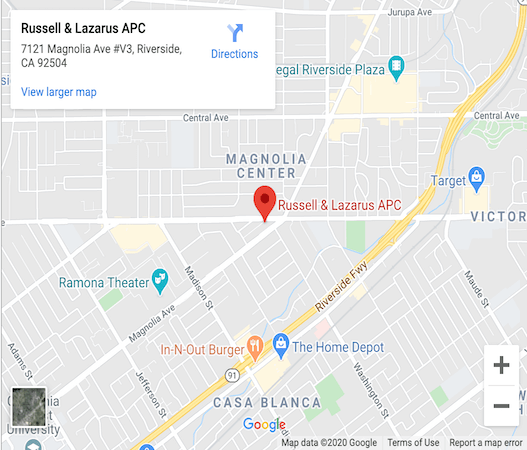
Phone: (951) 485-4000
Toll-Free: (800) 268-9228
Grandville Executive Suites
7121 Magnolia Ave., #V3
Riverside, CA 92504

